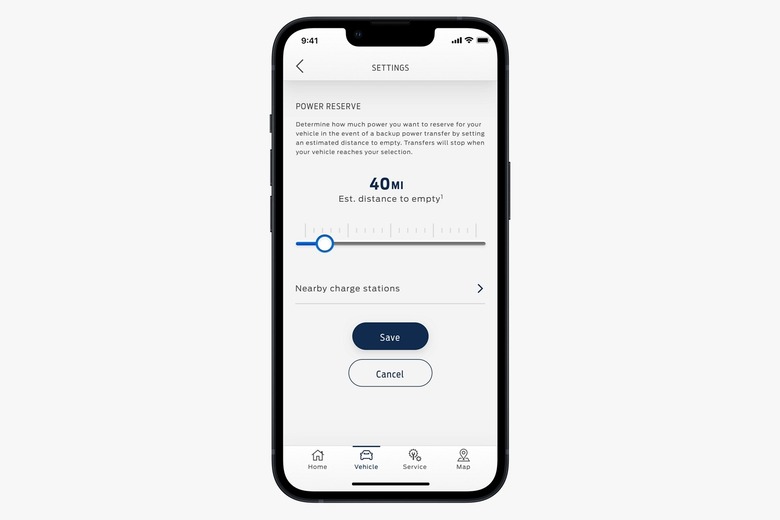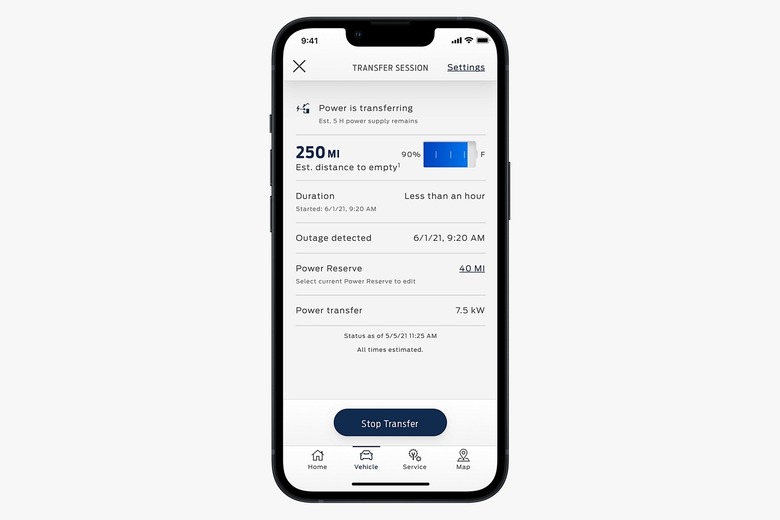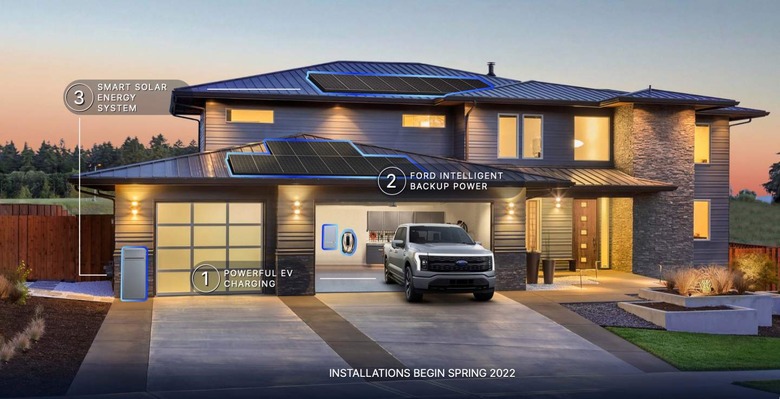This Is How The Ford F-150 Lightning EV Can Power Your Home
Ford's F-150 Lightning may be the first F-Series truck to go all-electric, but arguably the game-changing feature of the pickup EV happens when it's parked up and plugged in. Ford Intelligent Backup Power builds on the increasing availability of power outlets in EVs and hybrids, with bi-directional charging that can keep a home running in the case of a grid outage. Promised when Ford unveiled the F-150 Lightning, we're now getting more details on how the Powerwall-style battery backup feature will work.
Home backup batteries aren't new, of course. Probably the best-known at the moment is Tesla's Powerwall system, effectively the same batteries that are found in its electric cars, but designed to provide a backup supply of power for a home. Several other companies also offer similar systems.
That backup power could be most useful during a power outage, when the regular grid supply goes down. However, it also offers more flexibility when it comes to power pricing. Powerwall and other such systems can typically charge up when electric rates are low, and then supply that electricity to the home when rates are higher, for a lower overall cost with no need to ration what you have plugged in and turned on.
Ford Intelligent Backup Power is a Powerwall on wheels
With the 2022 F-150 Lightning having as much onboard battery capacity as many home backup batteries do, taking advantage of that for more than just driving range seemed like an obvious strategy. While the F-150 Lightning – and other models in the range, like the F-150 PowerBoost Hybrid – has 110V outlets into which you could plug appliances, tools, or other devices, Intelligent Backup Power is a more serious system. It offers true bidirectional charging support.
Normally, when the truck is plugged in, it's charging from your home electricity supply. If that supply lapses, however, such as because of a grid outage due to storms or other issues, the flow of power can reverse. The F-150 Lightning actually powers the home instead.

Ford says that, with up to 131 kilowatt-hours in the F-150 Lightning extended-range battery, and up to 9.6 kilowatts of power supplied through the connection, the typical US home could run at full power for up to three days. With some sensible rationing – like not running electricity-hungry appliances – that could be extended to up to 10 days, the automaker estimates. Obviously different homes and situations will see that number vary, but the overall goal is independence from the grid when needs demand it.
When the power goes down, the F-150 Lightning automatically begins supplying electricity. When the grid returns, meanwhile, the truck switches back into charging mode. It's all designed to take place without any interaction from the homeowner, though you'll be able to use Ford's app to set a reserve limit under which the EV's battery won't drop. That means you can still drive it in the case of an emergency.

Does the Ford F-150 Lightning need a special charger?
You can charge up the F-150 Lightning with a regular Level 2 home charger, or a public DC fast charger for much quicker rates. Those standard chargers, however, typically aren't set up for bidirectional power. For that, you'll need something like Ford's own Charge Station Pro.
That'll be included with the extended-range F-150 Lightning, while those who opt for the standard-range version of the EV can buy the charger separately. It's a more potent, 80-amp version of Ford's usual charger, and it supports being connected to what's being branded as the Home Integration System.

Ford worked with Sunrun – a solar panel installer – to develop that, and it's basically a transfer switch plus some other features. The transfer switch allows the home's breaker panel to flip between grid supply and another supply – in this case the EV pickup – and then back over again. It's combined here with a power inverter, which changes the DC power from the F-150 Lightning's battery to AC power a home can use, and a dark start battery to help bridge the changeover.
To begin with, the Home Integration System will handle outage switchovers. Down the line, though, Ford has more features planned, which it expects to roll out to the system. Ford Intelligent Power will allow for load shifting based on utility pricing, switching between the grid and the F-150 Lightning's battery depending on the current cost of electricity. It could also help reduce load on the grid during periods of excessive use, such as we've seen happen in Texas during winter storms, where poorly-equipped infrastructure was brought down by too much demand.
Solar is optional, but brings some big advantages
While home backup batteries are typically considered an extension of a solar power system, they're not necessarily always combined. You can have solar without batteries, or batteries without solar, though there are compromises along the way in both situations. In the case of Ford Intelligent Backup Power, solar is a nice-to-have but not essential.

With solar, F-150 Lightning owners will be able to use the sun's energy to help charge the EV's battery up, just as they would with other electric vehicles. However when the truck is providing power to the home, solar can contribute to that too. It could mean less electricity rationing without sacrificing what you have plugged in, weather-depending.
Sunrun will be offering solar installation for those who want to combine the two, and is already talking about potentially lower installation fees for those who do so. If you already have a solar system, you should be able to tie that into the Home Integration System too.
Do I have to use Sunrun for installation?
While Sunrun is Ford's preferred installer, it's not mandatory to use the company. Indeed, as it offers installation and solar services in 22 US states and DC – Arizona, California, Colorado, Connecticut, Florida, Hawaii, Illinois, Maryland, Massachusetts, Nevada, New Hampshire, New Jersey, New Mexico, New York, Pennsylvania, Puerto Rico, Rhode Island, South Carolina, Texas, Vermont, Washington DC, and Wisconsin – there'll be some areas where you need to look elsewhere. Sunrun says it can offer referral or other installation options for those other states, while its own installations – which can begin before F-150 Lightning reservation-holders have actually taken delivery of their trucks – will start in Spring 2022.

It'll be selling the Home Integration System hardware separately, for those who want to use their own electrician instead; pricing for that will be confirmed later on, the company says. The special high-power EV charger can be installed indoors or outdoors, depending on where the F-150 Lightning is likely to be parked.
One thing to bear in mind is that not all home electric wiring will be ready for bidirectional power. The main electricity panel might need to be upgraded, for example, to make sure there's a dedicated 100-amp circuit available for the charger. Trenching – to route new cables or replace existing ones – might also add costs.
As with gas home backup generators, then, the exact price of all this could vary considerably depending on factors like where you live, how old your home is, and what the existing wiring is like. Still, with outages an increasing fact of life in many US states, it's not hard to see why bidirectional power is one of the growing areas of focus for new electric vehicles. While the F-150 Lightning may be among the first to popularize the technology, you can expect it to proliferate as more drivers begin to expect greater flexibility and functionality from the hefty batteries they're paying for.
